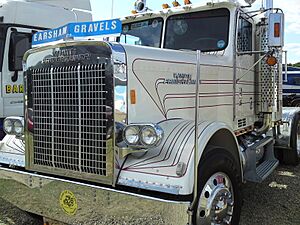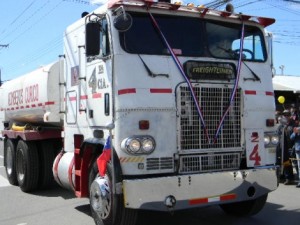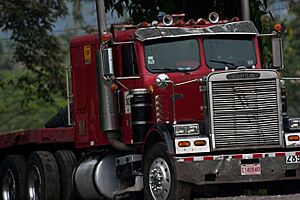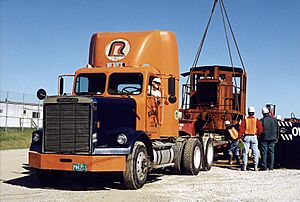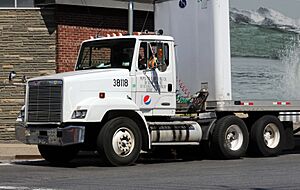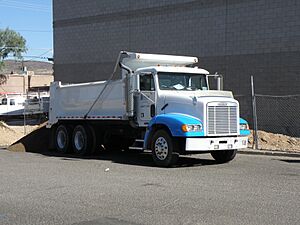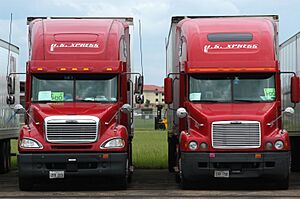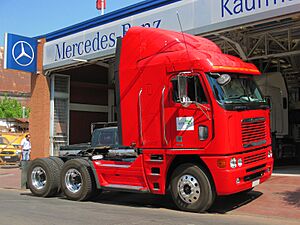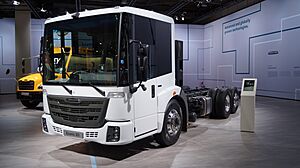Freightliner Trucks facts for kids
 |
|
| Subsidiary | |
| Industry | Automotive |
| Founded | 1942 (as Freightliner Inc) |
| Founder | Leland James |
| Headquarters | Portland, Oregon, U.S. |
|
Area served
|
|
|
Key people
|
John O'Leary, CEO |
| Products | Commercial Vehicles, Luxury vehicles |
| Owner | Daimler Truck |
| Parent | Daimler Truck North America |
Freightliner Trucks is a famous American company that makes big trucks, like the ones you see on highways! It started way back in 1929 as a part of another company called Consolidated Freightways. In 1942, it became its own company, Freightliner Corporation.
For many years, Freightliner was owned by Daimler Truck. Now, it's a big part of Daimler Truck North America, which also includes other truck brands like Western Star and Thomas Built Buses.
Freightliner builds many types of vehicles, from vans to huge heavy-duty trucks. They also make special parts called "chassis" for different kinds of vehicles, like delivery vans and buses. They were also known for making "cabover" trucks, where the driver's cab sits right over the engine.
The company's main office is in Portland, Oregon, where it first began. Today, Freightliner trucks are built in places like Cleveland, North Carolina, Mount Holly, North Carolina, and in Mexico.
Contents
- The Story of Freightliner Trucks
- Freightliner Truck Models
- See also
The Story of Freightliner Trucks
How Freightliner Began (1930s)
Freightliner's story started in 1929. A company called Consolidated Freightways (CF) in Portland, Oregon, needed special trucks. So, its founder, Leland James, created a part of the company just to build trucks for them.
These early trucks were designed to be shorter. This allowed CF to pull longer trailers and still follow the rules about how long trucks could be on the road. During the 1930s, these trucks started to be called "Freightliner." They were also made lighter using aluminum instead of heavy steel. This helped them climb mountains better, especially in the western United States.
Growing in the 1940s and 1950s
In 1942, Leland James officially named the truck-making part of his company Freightliner Corporation. That year, they also showed off their first truck with a cab made entirely of aluminum!
After helping with military production during World War II, Freightliner started making trucks for everyone again in 1947. In 1949, they sold their first truck to a company outside of Consolidated Freightways. This special truck is now kept in the Smithsonian museum in Washington, D.C.!
To sell more trucks, Freightliner teamed up with White Motor Company in 1951. White Motor Company was one of the biggest truck makers then. They sold Freightliner's cabover trucks under the name "White Freightliner."
In 1953, Freightliner made a new cab design that had a sleeping area right above the driver. This made the truck even shorter! A few years later, in 1958, they made the cab able to tilt forward. This made it much easier for mechanics to work on the engine.
The 1960s: Expanding Production
To avoid extra taxes when selling trucks in Canada, Freightliner opened its first factory there in 1961. It was located in Burnaby, British Columbia. To make even more trucks in the United States, they opened new assembly plants in California and Indiana. By 1969, a second factory was opened in Portland just for making truck parts.
The 1970s: Becoming Independent
In the 1970s, the White Motor Company faced some problems. Because of this, Freightliner ended its agreement with them in 1974. This meant Freightliner Corp. became a completely independent company, making and selling its own trucks. Many of the first dealers who sold Freightliner trucks had previously worked with White Motor Co.
Around this time, Freightliner also introduced its first "conventional" truck model. Unlike cabovers, conventional trucks have the engine in front of the cab, like most cars. These were popular in the western United States because they were more comfortable and easier to fix.
In 1979, Freightliner built new factories in Mount Holly, North Carolina, and Gastonia, North Carolina, to keep up with growing demand. Also in 1979, new laws were passed that changed how the trucking industry worked, allowing for more competition.
The 1980s: A New Owner
In 1982, new laws changed truck weight and length rules. This meant that the overall length of a truck and trailer was no longer as restricted. This was a big change for the trucking world.
Because of these changes, Consolidated Freightways decided to focus only on its trucking business. In May 1981, they sold Freightliner and its truck-making business to Daimler-Benz (a German company, now part of Daimler Truck). Around this time, some older Freightliner plants were closed.
In 1985, Freightliner introduced a new series of medium-sized trucks called the FLC112. These trucks used parts of the cab from Mercedes-Benz trucks. In 1989, Freightliner bought a factory in Cleveland, North Carolina, which had been making buses.
The 1990s: Growing and Diversifying
In 1991, Daimler-Benz decided that Freightliner would handle all their medium-duty trucks. This led to the launch of the Business Class trucks. These were smaller versions of the FLC112 and became very popular.
To help the company's finances, some big changes were made. The factory in Burnaby, British Columbia, was closed, and a new one opened in St. Thomas, Ontario. Production also started in Santiago Tianguistenco, Mexico.
Freightliner continued to grow its truck lineup. In 1996, they introduced the Freightliner Century Class, a completely new large truck. A year later, they started making bus chassis, like the Freightliner FS-65, which was based on their medium-duty trucks.
In 1999, the Freightliner Argosy debuted. This new cabover truck combined several older models into one. It was designed to have more space inside the cab. Also in 1997, Freightliner bought the truck-making part of the Ford Motor Company and renamed it Sterling.
By 1999, Freightliner had built its one-millionth vehicle! The Century Class family of trucks also grew, adding the Columbia model.
Expanding the Company
The 1990s were a very busy time for Freightliner. The company bought many other businesses to offer more types of vehicles:
- 1995: They bought Oshkosh Custom Chassis, which became Freightliner Custom Chassis. This company makes the base parts for delivery vans (like those used by UPS), recreational vehicles, and school buses.
- 1996: They bought American LaFrance, a company that made fire trucks for over 130 years.
- 1997: After buying Ford's heavy-truck business, Freightliner created Sterling Trucks. Sterling trucks were mainly for special jobs and were updated versions of Ford's truck models.
- 1998: Freightliner bought the bus manufacturer Thomas Built Buses. Sterling trucks also started being built in St. Thomas, Ontario.
The 2000s: New Models and Changes
At the start of the 2000s, Freightliner was part of DaimlerChrysler. In 2000, they bought Western Star Trucks, another truck maker, and Detroit Diesel, a company that makes engines.
The economy was difficult, and Freightliner had too many used trucks they couldn't sell. They also had many businesses that weren't doing well. So, new leaders were brought in to help. By 2002, some factories were closed to make the company stronger.
In 2002, Freightliner updated many of its truck models. For medium-duty trucks, they introduced the second-generation Business Class M2. This truck was designed entirely by Freightliner. They also added the Freightliner Coronado to their large truck lineup, which was a premium truck for truck owners. For special jobs like garbage collection, they introduced the Freightliner Condor, a truck with a low-entry cab.
Some of Freightliner's other businesses also changed. The production of American LaFrance fire trucks was moved to a former Western Star plant, but it didn't work out well. American LaFrance was sold in 2005.
In 2006, the Sprinter van was redesigned. Freightliner also started assembling these vans in South Carolina. While mostly sold as cargo vans, the Freightliner Sprinter was also available for passengers.
After 2006, Freightliner stopped selling the Argosy cabover truck in North America. They were the last truck maker in North America to offer a large cabover truck. However, the Argosy continued to be made for export to other countries.
In 2007, DaimlerChrysler split up, and Freightliner's parent company became Daimler AG. Freightliner also started making trucks in Saltillo, Mexico. On January 7, 2008, Freightliner LLC changed its name to Daimler Trucks North America, LLC (DTNA). This company now oversees Freightliner Trucks, Sterling, Western Star, Detroit Diesel, and Thomas Built Buses.
In 2008, the company introduced the Freightliner Cascadia, a new generation of large trucks. The Cascadia was designed to be very fuel-efficient, safe, and reliable.
In 2009, Freightliner began making natural gas versions of the Business Class M2. In March 2009, DTNA stopped making Sterling Trucks because they were too similar to Freightliner trucks. This also led to the closure of the St. Thomas plant.
The 2010s: Innovation and New Technologies
After Sterling trucks were stopped, Freightliner's truck lineup changed. Some older models like the FLD 120/132 Classic/Classic XL were discontinued in North America by 2010. Production of the Century Class also shifted entirely to export. The Coronado truck was joined by the Coronado SD, designed for tough jobs.
In 2010, Freightliner introduced its first hybrid truck, which used both diesel and electric power.
In 2011, they launched the SD model family, including the 108SD and 114SD, which were tough versions of the M2 Business Class. In 2012, Freightliner celebrated its 70th anniversary. They showed off a special concept truck called the Revolution, which had a unique design and was made from lightweight materials. Because the Cascadia truck was so popular, DTNA expanded its factory in Cleveland, North Carolina. Many of the trucks made there were exported to places like South Africa, Australia, and New Zealand.
In 2013, Freightliner added a natural-gas version of the Cascadia. They also introduced the Cascadia Evolution, which was even more aerodynamic and fuel-efficient. The Coronado was also added to the SD model family and renamed the 122SD.
On August 22, 2014, the Cleveland plant built the 3 millionth vehicle for Daimler Truck North America! It was a 2015 Cascadia Evolution.
In May 2015, the Freightliner Inspiration was shown. This was the first self-driving semi-truck allowed on public roads! It was based on a Cascadia and had a system similar to an airplane's autopilot, still needing a driver to be present.
For 2017, Freightliner introduced a second-generation Cascadia, which included design ideas from the Inspiration self-driving truck.
In 2018, Freightliner debuted the EconicSD, a low-entry truck mainly for garbage collection. It was based on the Mercedes-Benz Econic.
In September 2019, Daimler announced they would stop developing new gasoline and diesel engines for trucks. They wanted to focus more on electric vehicles.
The 2020s: Electric Trucks are Here!
As of August 2025, Freightliner is making big moves into electric vehicles! Their MT-series step van (called MT50e) is available as an all-electric vehicle. School buses built on Freightliner's chassis are also electric.
The eCascadia, an all-electric semi-truck, was given to customers for testing in 2019 and officially launched in May 2022. An all-electric version of the M2 box truck has also been tested. In 2022, Freightliner also revealed an updated version of the M2 Business Class series.
Freightliner Truck Models
Here are some of the different types of trucks Freightliner has made over the years:
| Model Family Name | Production Years | Cab Configuration | Notes |
|---|---|---|---|
| WFT (White-Freightliner) | 1958–1976 | Cabover/COE | |
|
1974–1976 | Conventional | First White-Freightliner conventional
120-inch BBC |
|
c. 1987 – 1997 | Cabover/COE | |
|
c. 1987 – 1997 | Cabover/COE | |
|
1976–1986 | Cabover/COE | Similar to WFT COE, renamed after White Motor Company stopped distributing them. |
| FLL-Series | 1976 – c. 2000 | Low-entry COE | A low-cab forward truck, used for special jobs. |
| Argosy |
|
Cabover/COE | A cabover truck based on the C-Series design. |
|
1977–1987 | Conventional | Updated in 1984.
A version with a setback axle was made from 1984-1987. The FLC112 is a different truck, part of the Business Class. |
|
1987–2010 | Conventional | An "aerodynamic" truck with smooth sides and curved bumpers. Came in 112 and 120-inch BBCs.
The Classic series (using an FLC hood) was introduced in 1990. The FLD SD (severe-duty) has a "Classic" (non-aerodynamic) hood. |
|
1990–2010 | Conventional | An FLD-based truck with a "traditional" hood design.
Classic = 120-inch BBC Classic XL = 132-inch BBC Later replaced by the Coronado. |
|
1996–present | Conventional | Replaced FLD-Series trucks in different stages.
Century Class and Columbia replaced the FLD 120. Coronado replaced Classic/Classic XL. Cascadia (2008) replaced both Century Class and Columbia; the second generation of this model line. New Cascadia (2017) is the third generation. eCascadia is the electric version. |
|
2011–present | Conventional | Tough, heavy-duty versions of the M2 Business Class.
Also includes the 122SD (which was the Coronado since 2013). |
| Model Family Name | Production Years | Cab configuration | Notes |
|---|---|---|---|
|
1985–2007 | Conventional | First-generation Business Class, shared its cab with the Mercedes-Benz LKN. |
| Condor | 2001–2013 | Low-cab COE | Made mostly for garbage trucks.
Also made by Sterling Trucks and American LaFrance. Available as a semi-truck. |
| EconicSD | 2018–present | Low-entry | A low-entry truck based on the Mercedes-Benz Econic truck.
Replaced the Condor. |
|
1999–2007 | Low-cab COE | Continued production of the Ford Cargo truck, adapted to the FL-Series chassis.
Also sold by Sterling (SC7000/SC8000). |
|
2001–2023 2001–2011 2024-Present |
Conventional | Second-generation Business Class, with a cab designed by Freightliner. M2 106 - 106-inch BBC M2 112 - 112-inch BBC
|
| Model Family Name | Production Years | Cab configuration | Notes |
|---|---|---|---|
|
c. 1995 – present | Step-van chassis | Made by Freightliner Custom Chassis Corporation.
MT50e is the electric version. |
| Freightliner Sprinter | 2001–2021 | Full-size van | A version of the Mercedes-Benz Sprinter van. Freightliner was the first company to sell this model in North America.
Sold as a cargo van (assembled in the United States from parts) and a passenger van (imported from Germany). Mercedes-Benz stopped Freightliner Sprinter sales in December 2021. The Sprinter is still made and sold under the Mercedes-Benz brand. |
|
1996–2006 | bus chassis | A bus chassis designed from the Business Class FL chassis; based on the FL60 and FL70. |
|
2001–present | Cutaway-cab/chassis | A cutaway cab version of the Business Class M2 10. |
|
2003–present | bus chassis | A school bus chassis designed for the Thomas Saf-T-Liner C2 bus body. |
See also
- List of companies based in Oregon
- Mercedes-Benz Actros
- Mercedes-Benz Zetros
- Mitsubishi Fuso Truck and Bus Corporation
- Western Star Trucks



